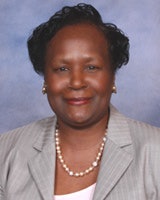 Dr. Gloria Kersey-Matusiak says, “Cultural competency is one strategy for eliminating the health disparity.”
Dr. Gloria Kersey-Matusiak says, “Cultural competency is one strategy for eliminating the health disparity.”Experts say that hidden bias against patients who are socially and economically disadvantaged are contributing to disparities in health care and outcomes for people of racial and ethnic minorities.
The poor and those who are socially disadvantaged or from racial and ethnic minorities continue to experience lower quality of health services, are less likely to receive routine medical procedures and have higher rates of disease and death than non-minorities, according to the American Medical Association (AMA).
While educational attainment and income are two major determinants associated with better health and health outcomes, studies show that disparities persist even when controlling for gender, condition, age and socioeconomic status according to the AMA.
Dr. Irene Dankwa-Mullan is acting deputy director of the Division of Extramural Scientific Programs for the National Institute on Minority Health and Health Disparities in Bethesda, Md. The organization is on the cutting edge of research on various aspects of health disparity.
“In the medical community, research shows that unconscious or implicit bias play a role in the medical decision-making and quality of care provided to patients,” Dankwa-Mullan said. “Research findings from neurology, social and cognitive psychology show that hidden biases operating in several institutions, including the medical community, and largely under the scope of human consciousness, influence the way we see and treat individuals, even when we are determined to be fair and objective.”
Organizations such as the Institute of Medicine, a nonprofit, nongovernmental organization that provides advice on medicine and health, have researched disparities and issued guidelines for health care providers and key stakeholders to eliminate differences in the quality of care that minority populations receive, compared to non-minorities, but the gap remains.
“How to reach the goal of eliminating health disparities or completely closing the health disparities gap remains largely undefined in the research community,” Dankwa-Mullan said. “However, it is possible to close the health disparities gap with persistent local, institutional and national efforts. The concept of achieving health equity entails special efforts to improve the health of health disparity populations and especially those who experience social and economic disadvantage.”
Dr. Gloria Kersey-Matusiak, RN, a nursing professor and author based in Philadelphia, said that convincing health providers to make “special efforts” to ensure health disparity populations are well served is a struggle.
“There are still a lot of nurses out there, doctors and health care workers that don’t realize there are gross disparities in, not just access to, the quality of care they receive,” Kersey-Matusiak said. “Something has to be done. Nurses are the largest collective group of health care providers in the country. Cultural competency is one strategy for eliminating the health disparity.”
Kersey-Matusiak teaches nursing at Holy Family University, a private college in Philadelphia. In 2013, she published a nursing textbook, Delivering Culturally Competent Nursing Care. She said individual health care workers should take the initiative to better understand the needs of patients who don’t share their ethnic or cultural background, lifestyle or economic status so they can deliver the best care, but many do not.
“When I talk to nurses, I’m amazed,” she said. “Some of them are on board and others are resistant to understanding the health disparities.”
Other experts agreed that better community resources, employment and education contribute to health and well-being, but that care providers often overlook the importance of understanding cultural differences and relating to those of different cultures.
Wayne Boatwright, vice president for diversity at Meridian Health in New Jersey, noted that it was the only state that has required medical students to take six hours of cultural-competency training.
“For some doctors, the first time they experience diversity is when they work with a patient who doesn’t speak the language, and they try to explain the instructions for how to care for a new baby, and the family just shakes their heads,” said Boatwright, who is also a board member of the Institute for Diversity in Health Management, an affiliate of the American Hospital Association.
With the enactment of the Affordable Care Act, more people of racial minorities now have health insurance, which has been a financial boon to the bottom line of hospitals, Boatwright said, but to keep the influx of newly insured patients, hospitals need to treat them well.
Hiring a diverse medical staff, particularly in management roles, is just as important as cultural competency. Increasingly, the bulk of patients coming through the doors of large city hospitals are members of racial and ethnic minorities, but hospital staffs across the country have been slow to make their staffs reflect the communities served, he said.
“Medical organizations need to do both,” he said. “They need to hire diversity, and they need to educate on cultural competency.”
In 2012, the AHA surveyed 5,000 hospitals and found that 11 percent had racial minorities in management, Boatwright said, adding that there was no excuse for the low percentage.
Two years later, the organization conducted the survey again.
“The numbers had not moved at all,” he said.
Naomi Hall is a writer based in the Philadelphia area.


















